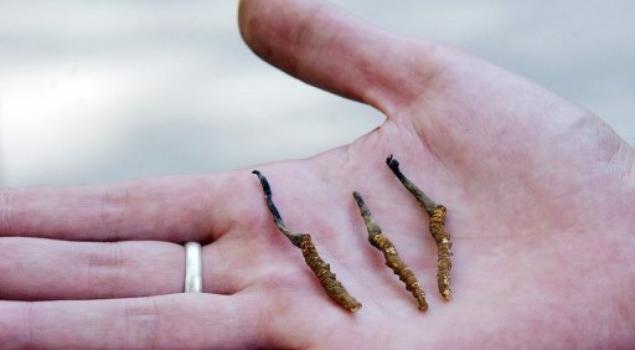June 11, 2012
A Nepali high altitude wild fungus – yarchagumba, is prized for it aphrodisiac qualities. But recent years have seen poor crop, partially impacted by climate change and that is raising concern among villagers who support their families by selling the "Himalayan Viagra."

June 11, 2012
A Nepali high altitude wild fungus – yarchagumba, is prized for it aphrodisiac qualities. But recent years have seen poor crop, partially impacted by climate change and that is raising concern among villagers who support their families by selling the "Himalayan Viagra."

Every summer, Himalayan villages empty as locals rush to the mountains of northern Nepal to harvest yarchagumba, a high-altitude wild fungus that is prized for its aphrodisiac qualities.
In recent years, however, the yield has been severely depleted by over-picking and the probable effects of climate change, experts have warned, prompting fears about the future of the "Himalayan Viagra" harvest.
This season's crop has been particularly poor, say the villagers who rely on the rare, parasitic fungus to earn money to feed their families.
"We returned home as we could not even collect more than 10 pieces of yarchagumba in a month," Nar Bahadur Bohara, who had been harvesting in the remote northwestern district of Darchula, told the Kathmandu Post.
"Those who had collected 150 to 200 pieces last year could make it only 20 to 30 pieces."
Fellow forager Narendra Thekare said the area had seen no rain for two months while winter snowfall, which is needed for the fungus to thrive, had been minimal.
"Production of yarchagumba has declined over the past five years. If this situation remains for some years, yarchagumba might vanish," Thekare said.
Neighbouring China has a huge appetite for the obscure fungus, pushing prices above $11,500 per pound (450 grams) and putting its value somewhere between silver and gold.
Despite declining harvests, the export trade still brings essential cash into the impoverished local economy with Darchula district earning about 7.3 million rupees ($85,000) last year, according to officials.
Thousands of foragers in the mountains are able to support their families for a year with a decent haul from the April to June season, but competition for yarchagumba can turn violent.
In November a court convicted 19 villagers over the murder of a group of seven farmers during a fight in 2009 over the fungus in Nar, an isolated village 13,000ft (4,000m) above sea level.
Yarchagumba is effectively two organisms, the larva of the Himalayan ghost moth and the Cordyceps fungus. The fungus spores attack the larva while it lives beneath the ground, killing it and causing a mushroom to sprout out of its head.
There has been no definitive research conducted by Western scientists but Chinese herbalists believe the fungus — an excellent balance of yin and yang, as it is both animal and vegetable — boosts sexual performance.
Boiled in water to make tea, or added to soups and stews, it is said to cure a variety of other ailments from fatigue to cancer.
It was relatively unknown to the West until 1993, when it was cited as one of the secrets behind the success of the Chinese women's record-setting track team at the world championships in Stuttgart, Germany that year.
Their coach boasted that he gave them the fungus in turtle blood.
A recent study by Uttam Babu Shrestha, a PhD scholar at the University of Massachusetts and a research associate at Harvard University, found yarchagumba yields declining considerably.
He found the average harvest in Dolpa, a Nepalese district which borders Tibet and accounts for more than 50 percent of the trade with China, had decreased from 267 pieces per harvester in 2006 to 125 pieces in 2010.
Shrestha attributes the decline to over-picking and climate change.
"It's worse this year. People have not been able to find any significant harvest," he told AFP by telephone from Dolpa.
"There are 16 pastures here and they were opened up 15 days ago. About 5,000 people have come here since then and searched for yarchagumba like they have always been doing, but they haven't found any."
Shrestha said he had been collecting reports from other pastures and the situation was as bad across the region.
"A clear reason for the problem is over-harvesting and premature harvesting but climate change has also been an issue.
"People were saying there was less snow in winter and temperatures were rising…. I'm pretty sure that if there is no intervention the yield will be further depleted," he said.
"Local people have the same feeling — that yarchagumba will be gone in 10 years."
Courtesy: Agence France Presse
















































































































